![]()
![]()
![]()
Use LEFT and RIGHT arrow keys to navigate between flashcards;
Use UP and DOWN arrow keys to flip the card;
H to show hint;
A reads text to speech;
77 Cards in this Set
- Front
- Back
|
List three things that would tell you it is unsafe to move a train in a yard as someone is still working on it? |
- Red Flag - Red Light - Not to be Moved board - Scotches - Shore Supply Cable connected - A 'Not To Go' or other repair label - The depot protection light is lit |
|
|
Before you make a shunting movement what two things must you agree with the shunter? |
- A clear understanding about what is required - How the shunting movement will be controlled |
|
|
What 3 things should you check underneath your train to ensure it is safe before moving your train? |
- Not over any facing points - No scotches - No dereailers |
|
|
What 3 methods can be used to control a shunting movement in a siding or depot? |
- Handsignals - Audible signals - Radio |
|
|
How would you use the following in a yard, siding or depot?
Frontal Lights – |
Warning Horn – Using only the low tone.
Frontal Lights – Only use the marker lights and turn the headlight off |
|
|
What is the max speed in a yard, siding or depot? |
5mph unless stated otherwise |
|
|
What lower speed might you have to adhere to and list one location in a yard where this might be necessary?
|
When entering a shed, building or train wash it is normally 3mph |
|
|
Handsignals - Day and Night
Move away: - Slow Down
Move Away Move towards
Stop Immediately Slowly move away
Slowly move towards Ease Up |
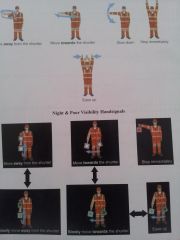
|
|
|
What three things must you do before entering the Depot shed? |
- Stop at the entrance - Only enter if you have been authorised by the shunter - Sound the horn and wait for the doors to open
|
|
|
List three reasons to stop a shunting movement? |
- If you lost sight of the shunter or their handsignals
- If you are unsure whether a handsignal applies to you.
- If you are unsure what a handsignal means
- If you lose communication with the shunter when using radio. |
|
|
What hand signal is given when permission to start movement a movement at a ground signal by day and night? |
One arm raised above head by day or a white light moved quickly by twisting the wrist by night. |
|
|
What four things do you check when leaving a train/stabling a unit?
|
- Not left foul of other lines - Clear of any points - Not left over spring point, trap points or derailers - Not left by mistake on a running line - Left secure |
|
|
What light do you leave on the rear of the train when a train is left on a dead end road? |
The same as whatever the buffer stop is displaying. |
|
|
What do the following audible signals mean
|
1 - Stop 2- Go Ahead 3 - Set Back |
|
|
Give two exception when you would drive other than from the leading cab? |
- If the driving controls in the leading cab are defective - You are propelling a completely defective unit |
|
|
If required to drive from other than the leading can where would you drive from? |
From the next forward facing cab if available |
|
|
Who would need to be in the leading cab before you make the move? |
A competent person
(eg. a shunter in a yard or a driver with the correct route knowledge) |
|
|
What four communication options are there to control the movement? |
1. Handsignals 2. Cab to Cab telephone 3. Using a radio 4. Using a bell or buzzer code |
|
|
What speed would you be able to travel during a propelling movement if
|
a) competent person can control automatic brake - 20mph
|
|
|
What is the basic principle of most signalling systems? |
One train in any block or signal section at any one time. |
|
|
Draw the sequence and explain 3 and 4 aspect signalling |
4 Aspect
Green aspect (second from top) Proceed Next signal displaying proceed aspect
Two Yellow aspects (top and third) Preliminary Caution Proceed: be prepared to find the next signal displaying one yellow aspect
One Yellow aspect (third from top) Caution Proceed: be prepared to stop at the next signal
Red aspect (bottom) Danger Stop |
|
|
When you change from 3 to 4 aspect signalling – what aspect is it possible to get if your last signal was a green aspect? |
A Single Yellow |
|
|
Draw and explain what you would see on a Route indicator |
1. First to the left 2. Second to the left 3. Third to the left 4. First to the right 5. Second to the right 6. Third to the right |
|
|
Draw and explain another method of route indication and what it can show |
A Theatre Box - Can show you letters or numbers |
|
|
What type or working is a main aspect colour signal with associated position light guarding? |
Permissive Working |
|
|
Draw a signal with an APL and four aspect when being signalled into an unoccupied section.
|
Proceed Aspect so either a Green, Single Yellow or Double Yellow aspect. |
|
|
Draw a signal with an APL and four aspect when being signalled into an occupied section. |
A Red signal with the APL displayed. |
|
|
How would you proceed if you had a red aspect Inc. APL and was signalled into an occupied section? |
Proceed with caution to the next signal or buffer stops and be prepared to stop short of any obstruction as the line a head may be blocked. |
|
|
How would you proceed past the above signal in thick fog |
Proceed at extreme caution (no speed restriction) |
|
|
Draw a banner repeater showing Off/On and clear aspects. |
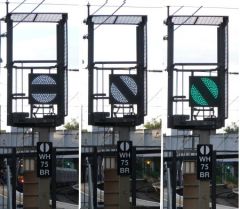
|
|

What do the following signs mean?
|
Red/ Red and white - Stop
Yellow/ Yellow and white - Stop, however you may pass this signal in a direction which it does not apply to when cleared.
White - Proceed cautiously towards the next signal or buffer stops and be prepared to stop short of any train or obstruction. |
|
|
How are route indications normally shown at position light signals? |
Stencil Indicator |
|
|
Draw the sequence at a flashing Jct where diverging junction has been set.
|
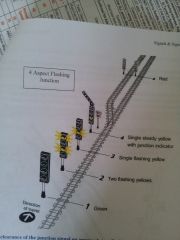
|
|
|
What does PoSA stand for? |
Proceed on sight authority |
|
|
When will POSA signalling be utilised |
When there is a failure of a signal or track circuit equipment. |
|
|
When must the signaller inform the driver that POSA will be introduced? |
- When authorising a train to pass a defective signal which is unable to display a main aspect
- When stopped at a signal approaching a mid-platform or platform starting signal has failed. |
|
|
What is the risk when approaching approach controlled junctions and what you must do to ensure you do not fall into this trap. |
The danger is that drivers may fall into the trap of always expecting the signal to change and could end up SPADing due to complacency. You must approach these signals and not expect that it will change. |
|
|
Draw and explain two types of Limit of Shunt Board? |

|
|
|
What does limit of shunt board normally mark and whose permission do you need to pass one. |
It indicates the limit of the wrong directional movement and you need the signaller's permission to pass it. |
|
|
Draw a Stop for order board and where would you find them? |

Usually found in depots, sidings or yards. |
|
|
What is a co-acting signal and why do we have them? How would you identify it? |
May be found in the 6ft adjacent to the main aspect in situations where the main aspect signal is hard to see. It shows the same as the main aspect signal which it relates to.
Can be identified by having 'CA' at the end of the signal plate. |
|
|
What would a SPAD indicator show when lit and what would you do if you saw one lit in your direction. |
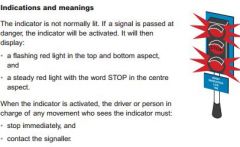
|
|
|
How would you know the following colour light signals were not in use
|
Main aspect signal - Bag with a cross on it
|
|
|
If following a train in permissive working arrangements how would you follow it and why? |
Proceed with caution so that if the train in front stops suddenly you can stop. |
|
|
When following a train down a permissive line when can you proceed passed the signal that the train in front has passed. |
You must allow for the train in front to pass the signal and wait for it to revert back to red and then wait until it clears. If unsure call the signaller to confirm. |
|
|
When a double unit into a dead end platform is uncoupled and you get in the rear portion but you find a fault – you want to test the unit , the signal is red what must you do before you make the movement and why? |
You must contact the signaller to seek permission to make the movement. This is because another train could be signalled to come in to the same platform due to the permissive working. |
|
|
List four things you must do should you accidentally pass a signal at danger |
Stop immediately Phone the signaller Answer questions Do not move |
|
|
Six occasions when you would set the DRA |
- Stopping at a station where the starting signal is danger - Stopped at any other signal at danger - Stopping at a station where no signal is provided and the last signal you passed was displaying caution - You enter a platform where no signal is provided after being authorised to pass the last signal at danger - You enter where no signal is provided after entering on the authority of a position light - Entering or leaving the cab |
|
|
What are the risks of overuse of the DRA? And not setting when you should?
|
If you over use it then it will lose its effectiveness. If not setting it when you should then you could proceed when the signal is showing danger and SPAD. |
|
|
List 5 things that constitute a signal irregularity |
- No signal is shown where there should be one - The aspect colour is not clear to see - There is no light shown at all - A white light is showing instead - A semaphore is not showing correctly - Only one light is showing in a position light |
|
|
When would you complete a RT3185 form for
b) Rightside failure |
a) Wrongside failure - You must inform the signaller immediately, stopping if necessary
b) Rightside failure - Do not need to stop immediately but must tell the signaller at the first opportunity |
|
|
What section of RT3185 can be completed later in your shift regarding the type of failure reported?
|
Section 6 |
|
|
When should the RT3185 be submitted once completed? |
As soon as possible but atleast before the end of your shift |
|
|
Give four reasons for AWS activation other than signals with restrictive aspects.
|
- Depot test magnet - A lit SPAD indicator - TSR - ESR - PSR - When first livening up the cab |
|
|
Draw and describe the following signs.
St Andrews Cross Yellow Square with Cross
AWS gap start AWS gap end
|
Permenent Cancellation Indicator Temporary Cancellation Indicator
AWS gap start - circle, 'AWS' with a cross AWS gap end - Square, 'AWS' |
|
|
What are two main reasons was TPWS introduced? |
1. To reduce the instances of SPADs 2. To reduce the consequences of SPADs |
|
|
List five occasions when TPWS brake intervention will take place. |
- Approaching buffer stops to fast - Approaching a danger signal to fast - Approaching a PSR to fast - Passing a TPWS fitted signal at danger - Not canceling the AWS warning indication |
|
|
What is the name of the TPWS equipment fitted on approach to buffer stops, speed restrictions and signals? |
Overspeed Loops |
|
|
What is the name of the loops at a the signal |
Train Stop Loops |
|
|
At what distance are TPWS loops fitted before buffer stops and what speed do you approach them? |
Positioned 50m from buffer stop and 10mph speed limit when approaching. |
|
|
At a main aspect signal fitted with an associated position light, which TPWS loop will remain energised and why? If APL shows proceed. |
The Overspeed loops because it needs to be energised for any other trains in the permissive working section. |
|
|
Name six things in the cab associated with AWS/TPWS system. |
- AWS cancel button - Visual indicator, sunflower - AWS Audio indications - Temporary override switch - TPWS full isolation - TPWS control panel |
|
|
Explain the TPWS panel? Draw |
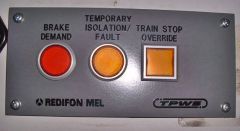
Brake Demand (red circle)
Temporary Isolation/ Fault (yellow circle)
Train Stop Override (yellow square) |
|
|
What are the different possible states that the TPWS lights can display? |
Brake Demand
1. No Light - No system intervention
2. Flashing Red Light - Brake application initiated by the TPWS Overspeed or Train Stop Loops
3. Steady Red Light - Brake application has been acknowledged by the driver
Temporary Isolation/Fault
1. No Light - TPWS system is fully operational
2 Flashing Yellow Light - A fault has developed on the TPWS system. (report fault and isolate if necessary)
3. Steady Yellow Light - TPWS has been Temporarily Isolated. The AWS will work normally.
Train Stop Override
1. Button illuminates when pressed
2. Button is spring loaded and overrides the Train Stop Loops for 20 secs.
3. The yellow button will go out and the override is automatically cancelled once clear of the Train Stop Loops or 20 secs has elapsed. |
|
|
What are the three occasions when you would have to activate the TPWS temporary isolation switch? |
- When several signals need to be passed at danger eg. TBW
- When the TPWS system is showing a fault
- If propelling (so train stop loops do not activate when the rear activated cab passes as the signal will change to red when front cab passes) |
|
|
What part of the AWS/TPWS system will still operate even if the temp isolation is selected? |
AWS system will still work |
|
|
If the TPWS/AWS became faulty can a train still enter service?
|
When the TPWS/AWS fault is in a cab which will not be driven (could be the middle cab boxed in so will not be used) |
|
|
What should you do if you develop an AWS/TPWS fault in service |
Stop Immediately Contact the signaller Await instructions Act on instructions |
|
|
If you are to continue to a suitable location to take the train out of service what restrictions are there if you have a competent person with you?
or No competent person
|
Competent person - Linespeed unless fog or snow (40mph)
No Competent person - 40mph |
|
|
What is the definition of a competent person? |
Another qualified person who has the route knowledge. |
|
|
What are the driver and competent person’s duties on route to a place where the train is taken out of service?
|
Driver - Give a running commentary of everything they are doing especially on approach to speed restrictions and signals.
Competent person - Acknowledge the driver's commentary regarding approach to speed restrictions and signals and remind the driver of anything they should be reacting to. They should stop the train if safety is compromised. |
|
|
Why do we have strict procedures when taking trains out of service due to defective equipment?
|
Because with on board safety systems not working it poses a risk to itself and other trains until taken out of service. The restrictions are placed to reduce this risk. |
|
|
Explain the three main wrong side failures: |
5 - AWS bell sounds when should be AWS horn 7 - No AWS indication when expecting the AWS horn 16 - TPWS loops do not apply brake application when it should do |
|
|
When do we complete the RT3185 form in above circumstances? |
Immediately with the signaller and handed in before the end of your turn. |
|
|
What should you do if your train experiences a TPWS brake intervention at a location other than at a location approaching buffer stops and what is the risk to you and your train if you don’t do this?
|
Stop immediately and contact the signaller as you may have passed a signal at danger without realising. You run the risk of a collision if you continue without contacting the signaller. |
|
|
If your train was to stop over an AWS beacon and you could not cancel what two options in order of preference have you got? |
- Contact the signaller and ask to change cab ends to move on
- Fully isolate the AWS/TPWS (will then need taking out of service to be reset) |
|
|
What do you find at a signal with TPWS Plus |
An additional set of TPWS loops |

